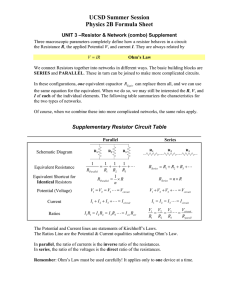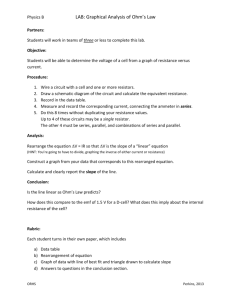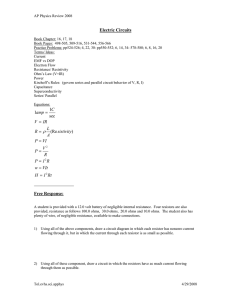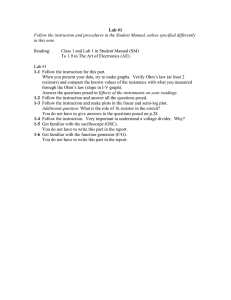6. Electric
advertisement
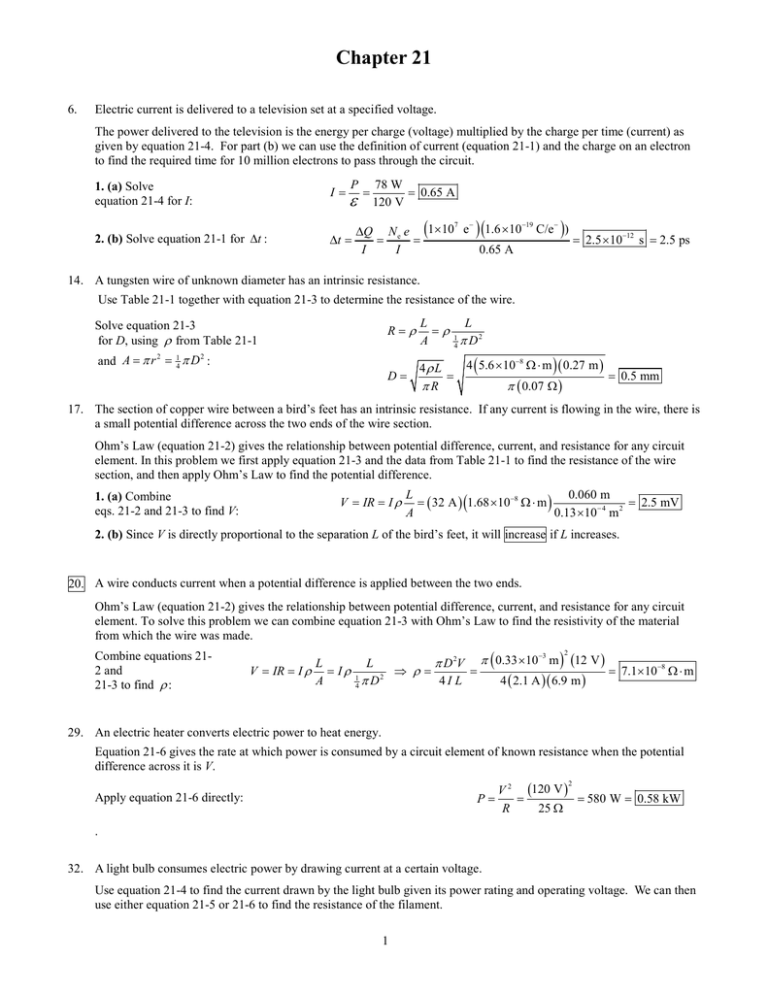
Chapter 21 6. Electric current is delivered to a television set at a specified voltage. The power delivered to the television is the energy per charge (voltage) multiplied by the charge per time (current) as given by equation 21-4. For part (b) we can use the definition of current (equation 21-1) and the charge on an electron to find the required time for 10 million electrons to pass through the circuit. P 78 W = = ε 120 V 1. (a) Solve equation 21-4 for I: I = 2. (b) Solve equation 21-1 for ∆t : ∆= t 0.65 A (1×10 ∆Q N e e = = I I 7 e − )(1.6 × 10−19 C/e − )) = 0.65 A 2.5 × 10−12 s= 2.5 ps 14. A tungsten wire of unknown diameter has an intrinsic resistance. Use Table 21-1 together with equation 21-3 to determine the resistance of the wire. Solve equation 21-3 for D, using ρ from Table 21-1 A π= r2 and= 1 4 L L = R ρ= ρ 1 A D2 π 4 π D2 : D = 4ρ L = πR 4 ( 5.6 × 10−8 Ω ⋅ m ) ( 0.27 m ) = π ( 0.07 Ω ) 0.5 mm 17. The section of copper wire between a bird’s feet has an intrinsic resistance. If any current is flowing in the wire, there is a small potential difference across the two ends of the wire section. Ohm’s Law (equation 21-2) gives the relationship between potential difference, current, and resistance for any circuit element. In this problem we first apply equation 21-3 and the data from Table 21-1 to find the resistance of the wire section, and then apply Ohm’s Law to find the potential difference. 1. (a) Combine eqs. 21-2 and 21-3 to find V: L V= IR = Iρ = A ( 32 A ) (1.68 ×10−8 Ω ⋅ m ) 0.060 m = 0.13 × 10− 4 m 2 2.5 mV 2. (b) Since V is directly proportional to the separation L of the bird’s feet, it will increase if L increases. 20. A wire conducts current when a potential difference is applied between the two ends. Ohm’s Law (equation 21-2) gives the relationship between potential difference, current, and resistance for any circuit element. To solve this problem we can combine equation 21-3 with Ohm’s Law to find the resistivity of the material from which the wire was made. Combine equations 212 and 21-3 to find ρ : −3 L L π D 2V π ( 0.33 × 10 m ) (12 V ) V= IR ρ = Iρ = Iρ 1 ⇒ = = = 2 A 4I L 4 ( 2.1 A )( 6.9 m ) 4πD 2 7.1× 10−8 Ω ⋅ m 29. An electric heater converts electric power to heat energy. Equation 21-6 gives the rate at which power is consumed by a circuit element of known resistance when the potential difference across it is V. = P Apply equation 21-6 directly: V2 = R (120 V ) 2 = 580 W = 25 Ω 0.58 kW . 32. A light bulb consumes electric power by drawing current at a certain voltage. Use equation 21-4 to find the current drawn by the light bulb given its power rating and operating voltage. We can then use either equation 21-5 or 21-6 to find the resistance of the filament. 1 P 75 W = = V 95 V 1. (a) Solve equation 21-4 for I: I = 2. (b) Solve equation 21-6 for R: V2 = R = P 3. (c) Form a ratio of the power ratings: Pnew V 2 Rnew Rold = = = Pold Rnew V 2 Rold ( 95 V ) 0.79 A 2 = 120 Ω = 75 W 0.12 kΩ Rold = 2 Rold 1 2 4. The power rating of the lamp with half the resistance would be greater by a factor of 2, or 150 W. 46. Three resistors are connected in parallel with a battery as indicated in the diagram at right. First write an expression for the equivalent resistance of the circuit using equation 21-10 and then apply Ohm’s Law to find the unknown resistance R. Since the same potential difference exists across each resistor, Ohm’s Law can be applied again to find the current through each resistor. I 1 1 1 1 = + + Req R1 R2 R 1. (a) Combine Ohm’s Law with Eq. 21-10: ε 2. Solve the expression for R: I 1 1 1 1 0.88 A R= − − = − − = 77 Ω 12.0 V 22 Ω 67 Ω ε R1 R2 = −1 3. (b) Now apply Ohm’s Law to R1 to find I1 : = I1 12.0 V = 22 Ω 0.55 A 4. Repeat step 3 to find I 2 : = I2 12.0 V = 67 Ω 0.18 A 5. Repeat step 3 to find I 3 : = I3 12.0 V = 77 Ω 0.16 A −1 6. (c) Since R ∝ 1 I , the answer to part (a) would have been smaller if I > 0.88 A. 52. Three resistors are connected in the manner indicated by the diagram at right, and a 12-V battery is connected to terminals A and B. Use the rules concerning resistors in series and in parallel to determine the equivalent resistance of the circuit. Begin by finding the equivalent resistance of the 55-Ω resistor connected in parallel with R, and then add the equivalent resistance of the pair to 12 Ω to find Req for the entire circuit. Apply Ohm’s Law to the entire circuit in order to find the current I 3 through the 12-Ω resistor. Ohm’s Law applied to the 12-Ω resistor by itself gives the voltage drop across the resistor, which can be subtracted from the total 12-V potential across A and B to give the voltage across the two resistors connected in parallel. Ohm’s Law can then be applied to each of those resistors in order to find the individual currents. −1 1 1 Req= 12 Ω + + = 45.4 Ω 55 Ω 85 Ω 1. (a) Find Req for the circuit if R = 85 Ω: = I3 2. Apply Ohm’s Law to find I 3 : 3. Find ∆V across the parallel resistors: 12 V = 45.4 Ω ∆V2 = 2 0.26 A ε − I 3 R3 = 12.0 V − ( 0.26 A )(12 Ω ) = 8.9 V 4. Apply Ohm’s Law to the 55-Ω resistor to find I1 : = I1 ∆V2 8.9 V = = R1 55 Ω 0.16 A 5. Repeat for the 85-Ω resistor: = I2 ∆V2 8.9V = = R 85 Ω 0.10 A 6. (b) Increasing R causes the resistance of the parallel path and of the entire circuit to increase, which in turn reduces the total current I 3 . Because R is now larger, I1 will get a proportionately larger share of the total current and I 2 a smaller share. As an extreme example, suppose R increases to infinity. Then = I 3 12 V= 67 Ω 0.18 A and I1 = I 3 because no current can pass through R. Thus, the current through the 12-Ω resistor and R decreases, and the current through the 55-Ω resistor increases. Insight: Another way to accomplish step 5 is to realize that I 2 must be the difference between I 3 and I 2 , or 0.26 − 0.16 A = 0.10 A. 54. Five resistors are connected to a battery that has an internal resistance, as indicated in the circuit diagram at the right. We must first find the equivalent resistance of the entire circuit and then apply Ohm’s Law to determine the current I that is drawn from the battery. To accomplish this we note that the 7.1-Ω and 5.8-Ω resistors are connected in series, and their 12.9-Ω equivalent resistance is connected in parallel with the 3.2-Ω resistor. The combination of those three resistors is connected in series with r and the 4.5-Ω and 1.0-Ω resistors. Once the current I through the battery is known, it can be used to find the potential drop across the internal resistance r and hence the potential across the terminals of the battery by using Ohm’s Law. 1. (a) Find Req by applying equations 12-7 and 12-10 as appropriate: 2. Apply Ohm’s Law to find I: 3. (b) Use I to find ∆Vbattery : −1 1 1 + R= 0.25 Ω + 4.5 Ω + 1.0 Ω + eq = 8.3 Ω 3.2 7.1 5.8 Ω Ω + Ω = I 12 V = 1.4 A 8.3 Ω Vbattery = ε − Ir = 12.0 V − (1.4 A )( 0.25 Ω ) = 11.6 V 4. (c) Increasing the resistance of the 3.2 Ω resistor will increase Req and decrease I, hence the current I1 will decrease. 68. Three capacitors are connected together as shown in the diagram at the right. Following the rules of combining capacitors, we can use equation 21-17 to find the equivalent capacitance of C2 and C3, and then add the result to C1 according to equation 21-14, because C1 is connected in parallel with the pair C2 and C3. Use equations 21-14 and 21-17 to find Ceq: −1 −1 1 1 1 1 Ceq =C1 + 15 µ F + + = + =21 µ F 8.2 µ F 22 µ F C2 C3 3


